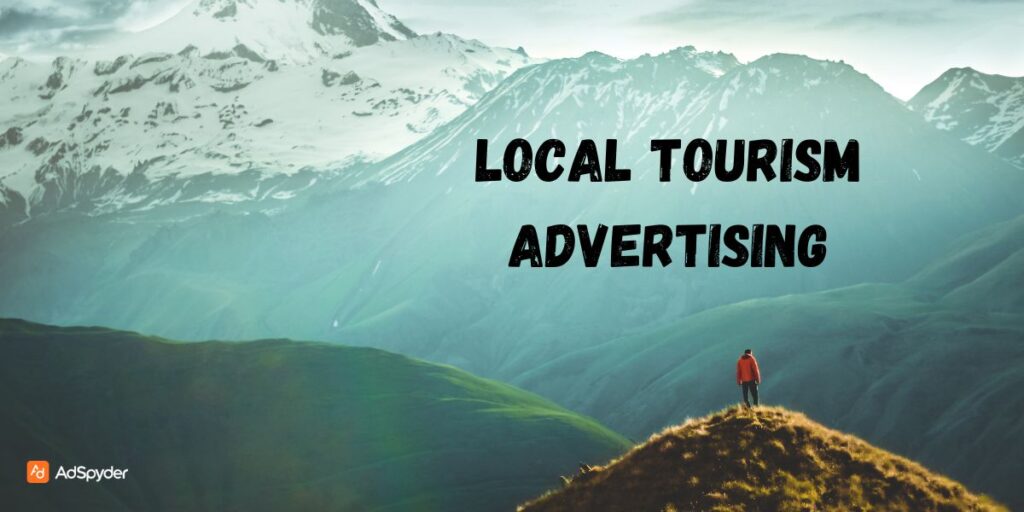Tourism functions as one of the dominant drivers of economic growth across many provincial areas, thus attracting visitors, which stands as the key to maintaining expansion. Local tourism marketing proves to be especially lucrative as an alternative strategy to national and international tourism advertising efforts. The advertising effort for local tourism encourages area residents to discover domestic attractions alongside neighbourhood lodging services and experiences. This marketing strategy delivers special benefits that strengthen community spirit and support neighbourhood enterprises while offering convenient travel solutions. The following guide will reveal everything needed to make successful local tourism ads that attract residents while promoting your region through tourism activities.
Ready to Elevate your Marketing Strategy?
Why Focus on Local Tourism Advertising?
Local tourism should represent the main focus of tourism marketing efforts, even though distant visitor attraction plays a vital role. While attracting tourists from afar is important, prioritising local tourism offers several distinct benefits:
- Accessibility: The limitations of local tour destinations enable visitors to reach their destinations with less effort and at cheaper expenses than long-distance travel and expensive flights. Tourism marketing now reaches more diverse travellers, including budget-sensitive families, people who work full-time, parents with children, students, and other potential regional travellers.
- Repeat Business: The revenue generated from local tourism becomes consistent because residents frequently return to visit again. A distinctive advantage of local tourism is that visitors can go back to their preferred locations and advertise those places to their companions while taking part in traditional annual celebrations.
- Community Pride: The promotion of local tourism helps local residents develop both community pride and local ownership beliefs. Residents who explore their home region develop into passionate defenders of local attractions, which enhances the positive perception of their territory.
- Economic Boost: The tourism sector in local communities supports the continuous growth of restaurants, hotels, shops, and attraction services. More tourist money spent creates employment opportunities, which in turn boost economic development to the benefit of the local community.
- Reduced Environmental Impact: Local travel’s reduced need for air travel produces fewer environmental repercussions because distances between destinations stay relatively short. Promoting local tourism leads to sustainable tourism standards. Local travel often involves shorter distances and less reliance on air travel, which can have a significant environmental impact.
- Resilience: Tourism within the local area enhances a region’s resilience to outside circumstances that affect international tourism. Focusing on local tourism can make a region’s tourism industry more resilient to external factors, such as economic downturns or global events that may impact international travel.
Understanding Your Local Audience for Local Tourism Advertising

Before launching any local tourism advertising campaign, it’s essential to understand your target audience. Any advertising effort for local tourism begins with studying your target audience. Which segments of the local population do you aim to bring into your establishment? Consider the following factors:
- Demographics: The audience description includes data points such as age group memberships and family status, along with annual income scale, yet education level and occupational information also matter.
- Interests: Their interests consist of recreational activities and personal interests. The audience in your area prefers, among other things, outdoor exploration combined with cultural activities while also enjoying food and drinks and historic sites.
- Motivations: People travelling locally continue their journeys because of various incentives. The audience seeks different travel experiences, which may include weekend breaks, family adventures, romantic destinations or short day visits.
- Travel Habits: People who travel locally show their behaviour patterns. Customers want to know what facilities they should use for their stay. People usually allocate how much they spend when touring.
- Information Sources: Their main sources for receiving knowledge about local attractions and upcoming events help answer this question. Clients obtain their information from social media platforms and local media, together with online reviews, while also listening to what people say about their destinations.
You can enhance marketing success via customised advertising through detailed descriptions of your local audience segments. By creating detailed audience personas, you can tailor your advertising messages and channels to resonate with specific segments of your local population.
Related – The Ultimate Guide to Retargeting Ads for Travel
Key Channels for Local Tourism Advertising
These following communication channels show the best results for local audience outreach and should be followed earnestly:
- Local Newspapers and Magazines: The printed pages of local newspapers and magazines provide an effective channel to advertise products since they deliver information to broad segments of older adults.
- Local Radio Stations: Targeting local listeners through radio advertisements represents an economic method to distribute marketing content across specified geographical regions.
- Community Events and Festivals: Sponsoring or taking part in community events together with festivals functions as an effective method to expose the tourism offerings to target audiences.
- Social Media Marketing: Your tourism brand can utilise Facebook, Instagram and Nextdoor social media platforms to deliver attractive ads and engaging content to local community residents.
- Local Blogs and Websites: Local website owners, along with bloggers, represent a great opportunity to deliver your tourism content to dedicated readers who want local travel experiences.
- Email Marketing: Email Marketing provides an opportunity to create a mailing list of neighbourhood residents through whom you can deliver event and special deal announcements and travel package promotions.
- Direct Mail Marketing: Targeted direct mail continues to be effective in reaching particular neighbourhoods and group demographics despite being categorised as traditional marketing.
- Partnerships with Local Businesses: Businesses should partner with neighbouring restaurants, hotels, and attractions to expand promotional prospects, which benefit everyone in the network.
- Visitor Information Centres: Your brochures, together with marketing materials, must be easily accessible at any visitor information centre that operates within your region.
Crafting Effective Advertising Messages
Your advertising messages must specifically capture the local customer preferences by advertising the region’s original features and available experiences.
Focus on Local Experiences
Advertise one-of-a-kind opportunities which allow place residents to adventure through their domestic attractions. Present the uncharted treasures of your area together with the beloved spots and period festivals that take place there.
Highlight Affordability and Accessibility
The promotion should feature both budget-friendly options and easy access to explore the local destinations. Local residents should benefit from custom offers combined with discount promotions and limited-time bundles.
Create a Sense of Discovery
Develop initiatives to help residents rediscover their home territory by displaying fresh attractions. The messaging should lead readers to a feeling of getting lost in exciting exploration.
Emphasise Community Pride
You should reach the local residents through their sense of community pride by encouraging them to support their regional business ecosystem while building the economic development of the area.
Use Compelling Visuals
Attract visitors by choosing professional images along with exciting video footage that demonstrates the attractive characteristics of your destination attractions. Visual components play a fundamental role when trying to win over audiences as potential visitors.
Tell Stories
A narrative that includes personal experiences proves highly successful in expressing the one-of-a-kind features of your place. Share stories about local people, places, and events to create an emotional connection with your audience. Personal stories can be particularly effective in conveying the unique character of your region.
Include Clear Calls to Action
To achieve results, direct your viewers specifically about what action you need them to perform. Your content needs to contain easy-to-understand actions, such as directing people to your website, offering booking possibilities, or spreading additional information. Ask your audience what action you want them to take. Use clear calls to action, such as “Visit our website,” “Book your stay,” or “Learn more.”
Target Your Messaging
Advertise according to your audience segments by designing individual messaging that speaks to their core interests and motivational reasons. Your advertising content should have distinct variations to reach both families with children, couples, and adventure enthusiasts.
Leveraging Digital Marketing for Local Tourism Advertising

Digital marketing plays a crucial role in reaching local audiences and promoting local tourism. Local audience reach and local tourism promotion fully depend on digital marketing strategies.
Search Engine Optimisation (SEO):
Search Engine Optimisation (SEO) strategies should focus on making website content and pages match local search queries so your tourism business will show up in search engine results during local area searches.
Local SEO:
Make your content focus on specific terms that describe your area and its places of interest, with the activities visitors can experience there. Your tourist business must claim and optimise its Google My Business profile so visitors can find correct information about your establishment. Request your clients to supply reviews through your business profile.
Social Media Marketing:
Social platforms should be leveraged to maintain local community engagement through beautiful content delivery while running location-based advertising to promote various regional activities. Your social media content will expand in reach when you add appropriate hashtags.
Paid Social Media Advertising:
It allows you to target specific audiences throughout your local area through focused advertising on various social platforms. Position your ads to target potential customers who live within your specific location. Run targeted ad campaigns on social media platforms to reach specific demographics and interests within your local area.
Content Marketing
Create valuable and engaging content, such as blog posts, articles, videos, and infographics, that showcase the unique experiences your region offers. We should try to circulate this content on your social media, website, social media, and other online channels.
Email Marketing
Create an email database of local residents to distribute regular newsletters containing upcoming event information and promotional offers, together with travel package details.
Online Reviews and Reputation Management
You should advocate that satisfied customers rate your business positively through popular services such as Google and Yelp, as well as TripAdvisor. Keep track of your online reputation while taking time to reply to reviews from both positive and negative sides.
Mobile Marketing
Optimise your website and your marketing materials to work well for mobile devices through Mobile Marketing campaigns. Local residents who search for information will mainly use smartphone devices to learn about area events, together with area attractions.
Measuring Success and ROI for Local Tourism Advertising
The evaluation of local tourism advertising success reveals your investment return and drives better decision-making for future advertising efforts.
Key Performance Indicators (KPI) for Measuring Success of Local Tourism Ads
Your campaign requires clear identification of key performance indicators (KPI) that correspond with your specific goals. The following metrics represent typical Key Performance Indicators that local tourism advertisers use:
- Website Traffic: Website Traffic measurement focuses on counting visitors who access your site from local IP addresses.
- Social Media Engagement: A strategic evaluation of social media engagement involves measuring all forms of user interaction, such as likes, shares, comments, and other actions on social media posts.
- Reach and Impressions: Your monitoring should reveal the total number of people exposed to your advertising content, including your promotional ads and other marketing elements.
- Conversions: You should measure the success rate of local actions that matter to you, such as hotel bookings, attraction tickets, or requests for downloadable promotional material.
- Foot Traffic: Local visitors should be counted whenever you promote a business at a physical address.
- Phone Calls and Inquiries: Record the quantity of local resident-generated phone calls together with inquiries that reach your business.
- Return on Investment (ROI): An ROI calculation for your advertising campaign requires comparing advertising costs with your revenue gains.
Methods for KPI Measurement for Local Tourism Advertising
- Google Analytics: The Google Analytics tool helps track website traffic alongside user behaviours, which result in conversions. Your campaign success should be determined through conversion tracking and goal setting to measure results.
- Social Media Analytics: Internet analytics tools embedded in social networking platforms help measure user interactions, together with audience size and additional metric data points.
- Customer Surveys: Initiate surveys among your community visitors to receive their thoughts about exploring your region, along with the factors that drive them to do so.
- Tracking Codes and UTM Parameters: The website performance analysis depends on tracking codes and UTM parameters that help identify the original source of website traffic and conversions. This metric enables you to identify the channels that produce the highest number of local tourism visitors.
Best Practices for Local Tourism Advertising

Some of the best practices that are religiously followed in the Local Tourism Advertising are as follows:
- Know Your Audience: Study your audience by determining the characteristics and psychological traits. along with the aspirations of people who reside in your area.
- Use a Multi-Channel Approach: Multiple channels should be used for outreach because they guarantee wider audience engagement.
- Create Compelling Content: Your content must be compelling by featuring authentic stories along with shots and photographs of high quality about local experiences.
- Emphasise Affordability and Accessibility: Promote special deals and discounts for local residents. Present specific promotions for local residents focused on affordable rates and accessible offers.
- Leverage Digital Marketing: Online promotion includes programming your website for geographical search along with social media advertising and running focused digital campaigns.
- Partner with Local Businesses: You should form alliances with other local businesses since these partnerships offer Marketing benefits that support both sides.
- Track Your Results: Results tracking enables you to monitor your Key Performance Indicators while making specified changes to your marketing campaigns.
- Stay Consistent: Enforce continuous marketing presence through every marketing platform you use.
- Build Relationships: You should approach the local people while creating bonds with community directors. Engage with local residents and build relationships with community leaders.
- Embrace Authenticity: Your region should display its genuine character as well as its authentic charm by embracing authenticity.
Common Mistakes to Avoid in Local Tourism Advertising
These are some of the mistakes that occur commonly, which can be avoided if we keep these in mind:
- Ignoring Local SEO: The failure to optimise your website and Google My Business for local search terms constitutes an error in local search engine optimisation.
- Not Targeting Your Audience: The use of non-relevant generic advertising material eliminates the connection between your messages and the targeted local audiences.
- Overlooking Offline Channels: Organisations make a mistake by dedicating all their resources to digital while disregarding standard advertising through local newspapers or radio.
- Failing to Track Results: The failure to track your KPIS without sufficient adjustments to your marketing campaigns becomes a major mistake.
- Neglecting Mobile Optimisation: The failure to optimise your website along with marketing materials for mobile platforms creates problems.
- Not Engaging with the Community: Failing to interact with local residents and build relationships with community leaders.
The Future of Local Tourism Advertising
Local tourism advertising development will be shaped by technological progress as well as adjustments in visitor purchasing habits. The following primary changes stand out in the market:
- Hyperlocal Targeting: The analysis of location and real-time information enables businesses to deliver highly specific targeted marketing at the neighbourhood level. More precise targeting based on location and real-time data.
- Personalised Experiences: The delivery of customised recommendations with personalised promotions happens through understanding what users prefer personally.
- Augmented Reality (AR) and Virtual Reality (VR): These platforms let locals access digital versions of attractions through immersive virtual experiences.
- Artificial Intelligence (AI): Artificial Intelligence (AI) tools enable the optimisation of marketing campaigns while tailoring messages to individual recipients.
- Focus on Sustainability: The promotional efforts will concentrate on developing sustainable tourism practices alongside responsible environmental initiatives.
Conclusion
Through local tourism advertising, you create opportunities to strengthen your local economy. You can raise community pride alongside providing friendly travel possibilities to regional residents. Your marketing program can succeed when you analyse customer profiles. Choose the best channels alongside message creation and performance measurement. This approach will lead to successful campaigns that draw neighbours into experiencing your backcountry attractions. Local tourism advertising success depends on persistent work. It needs regular adjustments while maintaining deep roots with your local community. Focus on authentic portrayal and focus on distinctive attractions and ongoing trend awareness. This can establish your region as the prime area for people within your territory to explore.
FAQs
What is local tourism advertising?
It promotes attractions, experiences, and accommodations for residents within a specific geographic area.
Why is local tourism important?
Local tourism represents an accessible option that generates continued visitation from customers. This is while strengthening community spirit, economic potency and maintaining sustainability.
How do I identify my local target audience?
Efforts to reach the local target audience should focus on their demographic details. This is in combination with their interests and motivations, together with their tourism patterns and information intake methods.
What are effective channels for local tourism advertising?
Local newspapers/radio, community events, social media, local blogs, email marketing, and partnerships.
What makes a good local tourism ad message?
Represent authentic places to visit and show reasonable prices. Foster a feeling of excitement through visual presentation and reinforce feelings of local pride.
How can digital marketing suceess be achieved in local tourism?
The success of local SEO is a result of social media marketing, targeted ads, content marketing, and online reputation management.
How do I measure the success of local tourism advertising?
Track website traffic and social media engagement. Track metrics and conversions of visitors and their return on investment (ROI) and site traffic.




